- Details
-
Created: Sunday, 02 July 2006 04:46
Editor: Ken is a very prolific writer, so we will let him tell his story in three consecutive issues. So, settle back and enjoy Ken’s affable manner as he describes his five weeks of carving in a strange and surprising land.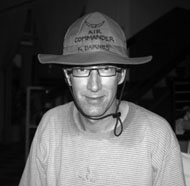
When writing about sculpting in Vietnam it is hard to write about carving stone in a foreign land. The process was certainly somewhat different than what I practice in my home studio, but the environment is the only reason to tell the story. If you asked me to write about sleeping in a foreign land I would not talk about the sleep, because hopefully it did not differ from my sleep at home. I would instead want to talk about the room, the bed, the sounds and smells, and even the meal that I ate that made me sleepy. So inevitably this will be more travelogue than description of my work in Chau Doc. After all, who wants to hear about how many fret cuts I made on the left side of the piece?
How Did I Discover This Opportunity?
I am on an e-mail list sent out by the Pacific Northwest Sculptors, an association similar to NWSSA that started in Portland several years back and has grown to incorporate Seattle (see www.pnsculptors.org for information). The e-mail had been lying unopened in my in-box for a while when Kalia Gentiluomo told me about the event. I quickly opened the note and saw that the closing date for applications was about two days later, so I immediately sent the organizing committee an e-mail with the information they were seeking. I got a call in less than 24 hours asking if I could attend. I had not seriously considered the possibility that I would be invited, so had to do some quick negotiations with my captors (bosses) to arrange time off at our busiest time of year.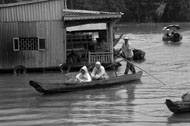
The offer seemed pretty good to me: I had to get myself there, but they would pay my room and board while there, provide a $500 honorarium, stone, helpers and any tools that I needed. I had to produce and donate one monumental stone work to their growing sculpture park in 40 days. It seemed a great chance for me to work in a monumental size while testing myself in a new environment and seeing another part of the world.
Where, What and Why?
Chau Doc is one of the main towns in An Giang Province in the south of Vietnam, and it gains its life blood from its location at the junction of two Mekong River tributaries, just south of where the Mekong flows out of Cambodia. Looking at the map before I left I figured this could not be part of the Mekong Delta, because it was over 100 miles from the sea, but I was wrong. The delta extends for well over 100 miles inland and Chau Doc was all about delta.
We were there at the end of the wet season, so many of the rice paddies were still under enough water to allow boat traffic. The water slowly receded during our visit, and by the time we left the small levies defining the borders of most paddies were showing themselves and the highest paddies were in full cultivation. Fill and roads have brought trucks, cars and motorbikes to the area, but boats are still a main method of transport. Outside of the commerce of town, it is safe to say that 100% of the economy and life revolves around the river. Fish and fishing are everywhere.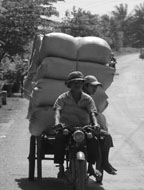
Chau Doc is the site of an important Buddhist temple on the side of a major lump of granite (a thousand feet tall) that sticks out of this water. The temple gets lots of visitors who each leave pocket change or more in the collection bins. The government keeps close watch on the finances of these temples, and if income exceeds expenses by more than a certain amount the government takes the surplus.
The temples find “qualified expenses” in order to avoid handing over cash to the government, one of which is community improvement projects. The finance chief of this particular temple is a sculpture fan, so he conceived of a sculpture park to improve the community and spend the dough. The city, province and national government liked the idea and also contributed a bit. The organizing committee had held its first symposium in 2003, and it got 40 sculptures for its park. Their goal was 100 sculptures, so they needed another 60 artists in 2005 to complete the park, and they wanted a 50/50 ratio of Vietnamese to international artists.
Day 1
Ho Chi Minh City (HCMC to all the locals, Saigon for Vietnam vets). I left Seattle at 4 am on a very comfortable Taiwan based EVA flight with lots of legroom. I snoozed a little, wandered the airport in Taipei while waiting for my connection, and then arrived at HCMC in the early afternoon.
I don’t know the population of HCMC, but I don’t doubt that every single one of them is on a motorbike in a solid river before me. The major streets have metal dividers in an attempt to contain the traffic flow to its correct side of the road. (The smaller roads are a free-for-all; biggest vehicle wins.) Unfortunately these dividers don’t keep all the traffic on the right side of the road. “Sneakers” run counter to the traffic flow, usually mixing in with pedestrians on the edge of the road. This makes it more interesting to get across the road in one piece. No question about why chickens cross the road here, they can’t. I recall from my last visit to Vietnam the correct technique for crossing this flow of motorbikes. You look into the traffic, take a deep breath, and then slowly but steadily walk across the stream. The motor molecules will maneuver to avoid you as long as you don’t move in a way that surprises them. I don’t have the guts to try this strategy when buses and cars are in the mix. I wait for them to pass.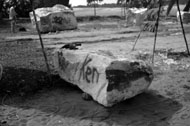
Day 3
I picked my stone on the carving site, found two internet cafes and scoped out the industrial shop part of town. In Vietnam the paint stores tend to cluster, as do the welding shops, the plumbing shops, etc. A shop is quite tiny by US standards, with a typical shop in Chau Doc occupying about the same amount of space as our home’s entry hall. In fact the shop is the entry hall to their house, with the living quarters behind the display area.
We had our welcoming ceremony in the evening, complete with drummers, dancers, singers and speeches by various important people, with a word from our sponsor, the temple. Then there was a raging party until late. I checked out at midnight, but others were pretty bleary eyed in the morning.
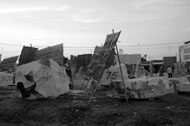
Day 4
The power is not up at the site yet, so I can’t really do anything. The gasoline powered air compressors are running the big hammer drills (like what they use in mining). They are moving around the site splitting large stones so that sculptors can start digging in. I am told that the power will not be up until 6pm so I hire a cyclo (bike with a little trailer behind for a passenger) and head into town to look for air hoses and plumbing fittings to make a multi-person air system. I find some of what I am looking for, but not enough. I need to come back with a translator, since doing it by myself is challenging. This is not a large enough town to have a shop with air manifolds, so I need to find various parts to build one myself. I have been given the title “air commander” by the foreign sculptors, since I am the main one concerned with getting my air tools working and am willing to lead the charge to get hoses and to produce a working manifold. The Vietnamese sculptors do not use air tools. The logistics chairman insists that the workers can do anything with their electric angle grinders, hammers and chisels and I should just let them do their work. I refuse to believe that I can live without a pneumatic polisher or air hammer and push onward toward making one small little hookup into their big compressors.
Typical Day
While I was in Vietnam I had this continual urge to write about my “typical day” on my blog, perhaps because one did not exist and I wished it had. So, I will fabricate a “typical day” from the bits and pieces of my actual days.
The sun rises at about 6 am. Since Chau Doc is near the equator the sun shoots straight up, as though from a launching pad. It is not the gradual arc of our summer sunrises in the northwest. The geckos in my room chirp and chase each other across the wall. They are not reptilian roosters cheering the sun; they have probably been chirping all night but I slept through it. The phone rings at 6:37 am, my programmed wake-up call from the front desk. I did not ask for it, but the reception believes that I want to get started early each day, and so provides me this considerate service (until I unplugged the phone). I do a mini yoga routine that I know will keep my back in good health, shave, brush my teeth, take my malaria pill and head to the communal breakfast. Others arrive at mostly the same time, perhaps due to the efforts of the wake-up calls. Those who stayed out late the night before singing and toasting with some clear liquid poured from a used plastic water bottle will not show up for breakfast until much later.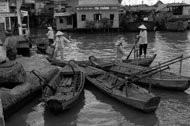
I wish for a continental breakfast, but am limited to the menu. The menu lists gruel (cold rice pudding with a plate of assorted dried fishies to sprinkle on top), vermicelli meat and noodles, and a couple of other less memorable dishes. Most mornings I order off menu with my special request of bread and laughing cow cheese. The vermicelli meat is actually decent but I don’t normally start my days with beef. The coffee is quite good, although I am not normally a coffee drinker. Midway through the 5-weeks there, I quit the morning tea, since it was giving me serious jitters. We eat together in small tables, which inevitably are pulled together into larger tables, and socialize until about 7:30 when we break up to go to the work site.
The work site is about ¼ mile down the road from the resort where we are staying. I feel sorry for the guests in the small hotel immediately adjacent to the site. There are 30 Vietnamese sculptors, 30 foreign (mostly Western) sculptors and about 80 Vietnamese helpers on the site. Most of the sculptors and helpers have an angle grinder going, and two large compressors power two crews with pneumatic rock drills to split large stones. The Vietnamese do not seem to mind environmental noise, and there are loudspeakers planted liberally throughout the country blaring news, propaganda, exercise routines, music and vendor’s calls. Perhaps the guests in the nearby hotel enjoyed the sounds of 100 angle grinders on stone as much as I.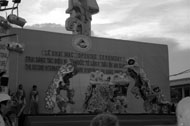
Editor: Stay tuned for the next installment...
- Details
-
Created: Saturday, 01 July 2006 23:34
In general, I think ideas for sculpture come around sort of like opportunities for food. Some come from deep within, like cravings from hunger pangs. Others are inspired from things I see: in bodies, in nature, in other works of art. This is sort of like being invited over for a meal.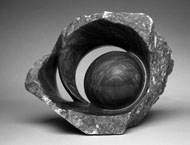
There’s fast food. Ideas that come quickly but aren’t that good. Often these are the ones that never get too far. They just don’t hold up as you spend more time with them.
Then there are the really great ones, like choice morsels, these ideas bring true joy to one’s palate. You get lost in them and you think about them long after the meal is over.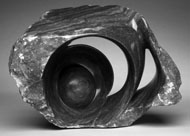
I have yet to get very savvy with narrowing my food choices any better than I have with choosing my ideas for sculpture. My ideas come from all over the place and I don’t follow a consistent path to completion. Some times I use maquettes to explore the ideas that come to me, at other times I carve directly on the stone without one. Usually, my maquettes are very rough drafts allowing freedom for dialog with the stone once started. I find some comfort with using a model to explore an idea in 3 dimensions since my sketching skills are, well, sketchy. Over the years I have created plastic bins full of various types of clay and wax maquettes, waiting for more development, or “their” rock, or for me to get my butt out to the studio.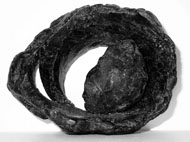
‘Saturn’ came about when I was trying to decide what to do next and I had no compelling ideas at hand. I was hungry but had no idea what to eat. I went out to the studio and walked up and down my row of rocks and one jumped out at me. Just like the ice cream out of the freezer! It was a colorful piece of Utah Alabaster. I picked it up, took it outside for a chat and we sat and looked at each other for a while. Well, I love to just sit and apparently rocks do too. We had a nice time and I clearly had a sense of what the piece “felt” like but could not get a clear vision. So, I took out some bronze casting wax and started playing around with some shapes. The color and lines of the stone really spoke of the swirling, organic nature of the planets and that’s the feeling I pursued. Within minutes a form appeared and that gave me a starting place. Then the easy part came, sitting down to the meal!











